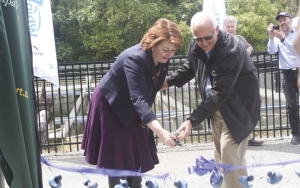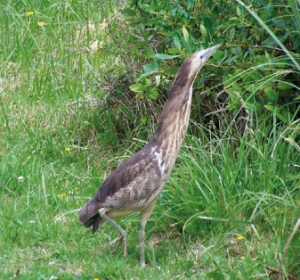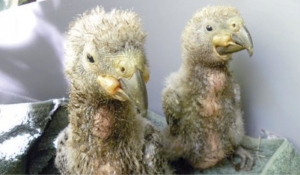Displaying items by tag: Breeding
Positive Whio captive results
Breeding Results 2013-2014
Queenstown pair did have one but it died at seven-weeks-old which was a shame. The pair from Auckland had infertile eggs but the female had been flocked mated not long before at Mt Bruce after losing her mate. The pair at Hamilton did nothing as well as the pair at Staglands. The pair at Palmerston North Esplanade did lay three eggs and one being fertile but died in the shell. The pair at Otorohonga did lay a clutch but nothing came from them.
Egmont met a milestone with 100 known birds on the mountain.
- 77 Eggs
- 49 Fertile
- 40 Hatched
- 33 Ducklings reared.
All released.
6 Captive breed.
Release Egmont March 13, 2014
14 Captive breed
2 Whione
Release Manganui –a-te-ao March 20, 2014
13 Captive breed birds
Released Birds to Date from 2000 to 2014
141 released Egmont National Park
25 released Manganui –a-te-ao
12 released Tongariro area
Deaths for the year 3.1
1 male Auckland Zoo 14 years
1 male Staglands 13 years
1 female Hamilton Zoo 18 years
1 male Otorohanga 3 years
Peter Russell
Northland Pateke recovery
Captive Breeding
Recovery Group Future
Takahē take to new home
Northern Regional Parks, Auckland Council.
Captive Whio and new facility
Takahe – a very special bird
The mother takahe was believed to be past breeding age, but she was sitting on an egg.
Takahe are endangered native birds with a population of only 327, including 100 breeding pairs.Todd Jenkinson said there are now 347 takahe around the country. They are endangered native birds and include 100 breeding pairs.
The Takahe were originally confined to Fiordland west of Lake Te Anau. They have a head and neck of iridescent indigo blue with back and tail olive green, with white under the tail, scarlet and pink beak, red legs and feet. You will know one if you ever see one.
Even though the Pukaha staff had assumed the 13-year-old Fomi would not have any more offspring, they were hoping the egg would produce a chick. The team were keeping a close eye on development and hoping the egg would produce a chick.
If the chick had hatched at the centre it would be the first Takahe chick hatched there in two decades.
Australasian bittern/matuku
Bitterns are found throughout New Zealand - in the North Island they predominantly inhabit Northland, Waikato and East Coast wetlands; while in the South Island they mostly inhabit West Coast, Canterbury and Southland wetlands. The most important bittern site nationally is Whangamarino Wetland, a large and diverse wetland complex in the Waikato.
Bitterns are large, stocky birds, with streaky dark brown and beige plumage on their throat, breast, abdomen and thighs; and dark brown on the neck and back. The head is dark except for pale beige around the cheek, forming a pale eyebrow. Plumage can vary significantly and may be age related.
Bitterns are rarely sighted due to their exceptionally cryptic behaviour, inconspicuous plumage resulting in excellent camouflage and the inaccessibility of many wetlands. They are mostly active at dawn, dusk and throughout the night. Bitterns are occasionally spotted in the open along wetland edges, drains, flooded farmland and roadsides.
They are very sensitive to disturbance and will silently creep away to avoid detection, or adopt the infamous ‘freeze’ stance (with the bill pointing skyward) if approached. This allows bitterns to blend into many environments, whilst maintaining a close watch of surroundings. If an observer continues to advance on a bittern, then it will eventually take flight in a laborious manner.
Often the only sign of bittern presence in a wetland is the male’s distinctive booming call at the beginning of the breeding season. Each call sequence may consist of 1-10 individual booms, with an average of 3 booms. Boom sequences are repeated at regular intervals, and normally preceded with inhalations or gasps. Females are mostly silent, apart from producing an occasional ‘bubbling’ sound upon return to the nest, or a nasal ‘kau’ when alarmed. Bitterns in flight may produce a resonant ‘kau’ or ‘kau kau’.
The breeding season is extremely long, spread over a 10-month period. Females construct a reed platform nest amongst dense vegetation deep within wetlands.
A clutch of 3-6 eggs is produced between August and December (peaking in November), and then incubated solely by the female for 25 days. Chicks remain in the nest for 7 weeks and fledge from November to May. Bitterns are considered an indicator of wetland health, as they are dependent on the presence of high quality and ecologically diverse habitats, which are rich in food supplies (such as eels, fish, freshwater crayfish, aquatic insects, molluscs, worms, spiders, frogs and lizards).
Bittern numbers have declined drastically since the arrival of European settlers, with over 90 percent of freshwater wetlands now drained and cleared. Ongoing wetland degradation continues to be the chief threat, resulting in habitat modification and loss, reduced food availability and poor water quality. Other threats contributing to bittern declines include predation by introduced mammals (particularly cats, rats, dogs and mustelids), human disturbance of nesting bitterns, as well as power-line and vehicle collisions.
You can help bitterns by becoming involved in wetland conservation and reporting all sightings (or calls) to your local Department of Conservation office. Most importantly you can protect wetlands on your property by planting native vegitation to create riparian buffers and fencing waterways from livestock.
Sabrina Luecht
Wildlife Project Administrator
(supplied by The Isaac Conservation and Wildlife Trust)
Lots of babies at Pukaha Mt Bruce
The Wairarapa breeding programme is going very well at Pukaha Mt Bruce. The Shore Plover programme has hatched 22 healthy chicks so far this year with five pairs now sitting on their third clutch.
The two pair of pateke are nesting again having so far successfully reared 12 ducklings between them.
The whio pair has three ducklings and there are three juvenile kiwi in the creche nearly ready for release as well as a kiwi chick hatched on Christmas Eve and one kiwi egg externally pipped and will hatch any day.
One red-crowned kakariki pair have three chicks to look after while another pair are waiting for their five eggs to hatch.
Wild kaka have this year utilised three of the nesting boxes with one pair already fledged and another three chicks not far behind.
Protecting our water birds
Whio News 2015
At Oparara/Ugly a 1080 drop in November 2014 was a success with rat numbers reduced from 58 before the drop to 0 after. Scott Freeman reported that summer was the best recorded at the site with 40 wild ducklings and five whione duckling released. Another 1080 drop was planned for this summer.
Kate Steffens reported from the Wangapka/ Fyfe site with very few floods and a dry summer they had the most productive whio season since monitoring began in 2003, with 36 fledgling from 16 pairs, and nine Whione juveniles were released from three clutches.
At the Te Urewera Whirinaki area they set up an entire site in one year instead of two. They installed 1600 double set DOC200s and needed volunteers to help with that. The heavy traps ranged between 16-24kg and had to be carried into the sites.
Tim Allerby reported the traps caught well. One block caught 26 stoats during one trap check.
Sara Treadgold reported a total of 22 confirmed whio paris were see within the Manganui o te Ao – Retaruke security site. This included 25 ducklings seen over the season.
Predator control saw 120 mustelids and 1372 rodents caught between July 2014-April 2015.
Tongariro Forest Security Site
Mild weather during spring along with a 1080 drop in August and a trap replacement programme saw a total 215 ducklings with 185 surviving to fledge.
A new trap line was installed on the Whakapapanui in Whakapapa Village run by Whakapapa residents. Interesting was the arrival of a whio of very pale colouring and paired up and set up territory on the Whakapapanui. (See Flight 162 p5.)
Egmont National Park Whio Recovery
The whio population at Egmont had a similar breeding success to the previous season and the census resulted in 86 whio being captured. Of these 31 were adult males, 31 were females and 17 were juveniles. (See Flight 163 p7.)
Egmont whio monitoring presents considerable effort with breeding across eight rivers within the National Park. From September 2014 to March 2015. A total of 32 pairs were located, an increase of two pairs on the previous season. A census was conducted with support and expertise of many whio practitioners and support from the Central North Island Blue Duck Trust. A total of 86 whio were captured though out the duration of the census.
Three adult birds caught were injured, two with head wounds consistent with injuries by stoats.
Captive breeding
Seventeen juveniles (including three females), were released into the Park. Ten whio including one female were released into the upper Waiwhakaiho River and seven including two females into the Little Maketawa Stream in February.
The trap network within Egmont National Park is serviced and maintained and since July 2014 trap catches were 245 stoats, 0 ferrets, 28 weasels, 16 cats and 1670 rats. Trap checks have continued for the 42 trap boxes on farmland.
Emily King
The 2014 season had been the best yet with 39 ducklings reared and 37 released back to the wild. These were from four pairs with Mt Bruce’s pair having three clutches and producing 16 young. A record for a pair in one breeding season. Peacock two pairs produced 18 and Orana Park pair produced five.
The big event for 2015 was the opening of the hardening facility at the Tongaririo Trout Hatchery which has turned out to be a great asset for getting captive juveniles ready for release.
Peter Russell
Shore Plover - Tuturuatu
There was a slow start to the New Zealand shore plover/tuturuatu breeding season, most likely due to the severe winter. The Isaac Conservation and Wildlife Trust said three out of four NZ shore plover pairs are breeding. The fourth pair had not bred last spring, due to a grumpy male.
The first clutches had been lifted for artificial incubation, with eight chicks hatched. Two second clutches have been lifted, with another due shortly. The third clutches will be left with the pairs to rear.
Chicks will be directly transferred to offshore island holding aviaries, rather than to Trust aviaries, a new move to minimise dispersal, due to protect hatch site. Department of Conservation monitoring on Waikawa/Portland Island recently reported five pairs on eggs and one pair with a chick.
Photographed (left), a recently hatched critically endangered shore plover chick as it checks out its brooder box surrounds on the hunt for tasty mealworms. Shore plover are one of New Zealand’s very rarest of birds and are one of the world’s most threatened waders. They continue to be on the brink and captive breeding efforts are essential in creating and maintaining translocated offshore island populations.”
Sabrina Luecht
Breeding success continues at Mt Bruce Pukaha
Breeding success continues at Mt Bruce Pukaha
Shore Plover:
26 chicks were raised with some released at Waikawa and some at Motutapu. Four remain at Pukaha to continue with the breeding programme.
Pateke:
18 ducklings from the two breeding pairs at Pukaha. These were sent to the pre-release site, Peacock Springs near Christchurch, before they are released into the wild.
Whio:
2 male and 1 female ducklings hatched and reared by a pair at Pukaha have been sent to the pre-release site at Turangi. 13 ducklings were hatched from eggs collected from wild sites and of these 9 are male and 4 are females. They will remain at Mt Bruce Pukaha.





